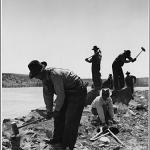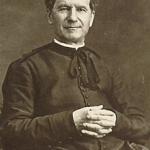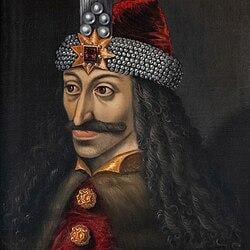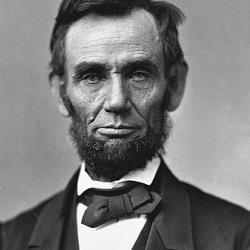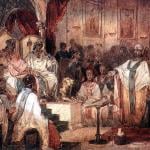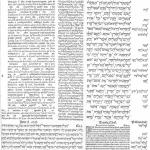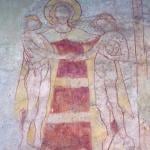Last Time on HOARATS
The Post Civil War Years – 1870 – 1879
As we enter into the
1880’s
Rutherford B. Hayes (1822–1893) was president # 44
March 4, 1877 – March 4, 1881
Leo XIII (March 2, 1810 – July 20, 1903) was Pope # 256
Papal Reign February 20, 1878 – July 20, 1903 (25 years, 150 days)
Electricity starts to be more widely used.
P.T. Barnum starts a circus and gets an elephant.
The first movie that takes place in a garden for about 3 seconds.
And Outlaws such as Jessie James, Billy the Kid and Black Bart roam the wild west
While a gunfight breaks out at the O.K. Corral.
1880
Picture This
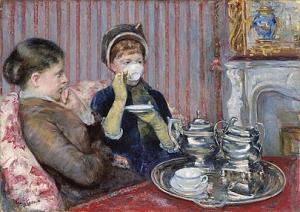
Robinson Crusoe and Man Friday – Carl Offterdinger
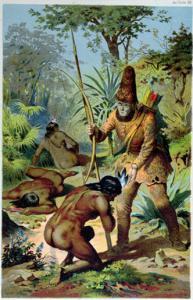
News of the World
- January 27 – Thomas Edison is granted a patent for the incandescent light bulb.
- February 2 – The first electric streetlight is installed in Wabash, Indiana.
- June 28 – Australian police capture bank robber Ned Kelly, after a gun battle at Glenrowan, Victoria.
- August 26 – Competing circus owners P. T. Barnum and James A. Bailey sign a contract in Bridgeport, Connecticut, to create the Barnum & Bailey Circus. In 1907, the circus will merge forces with another competitor, the Ringling Brothers Circus.
- November 4 – The first cash register is patented by James and John Ritty of Dayton, Ohio.
Arrivals
- Douglas MacArthur (January 26, 1880 – April 5, 1964) was an American military leader who served as General of the Army for the United States, as well as a field marshal to the Philippine Army. He served with distinction in World War I, was Chief of Staff of the United States Army during the 1930s and played a prominent role in the Pacific theater during World War II.
- Helen Keller (June 27, 1880 – June 1, 1968) was an American author, disability rights advocate, political activist and lecturer. Born in West Tuscumbia, Alabama, she lost her sight and her hearing after a bout of illness when she was 19 months old. She then communicated primarily using home signs until the age of seven, when she met her first teacher and life-long companion Anne Sullivan. Sullivan taught Keller language, including reading and writing. After an education at both specialist and mainstream schools, Keller attended Radcliffe College of Harvard University and became the first deafblind person in the United States to earn a Bachelor of Arts degree.[
- Elizabeth of the Trinity (July 18, 1880 –November 9, 1906) was a French Discalced Carmelite, a mystic, and a spiritual writer. She was known for the depth of her spiritual growth as a Carmelite as well as bleak periods in which her religious calling was perceived to be unsure according to those around her; she however was acknowledged for her persistence in pursuing the will of God and in devoting herself to the charism of the Carmelites.
- Johnny Gruelle (December 24, 1880 – January 9, 1938) the creator of Raggedy Ann and Raggedy Andy dolls and as the author/illustrator of dozens of books.
Departures
- Wallace Willis (1820 to 1880) writer of the hymn Swing Low, Sweet Chariot
- Ana Neri (December 13, 1814 – May 20, 1880) was a Brazilian nurse, considered the first in her country. She is best known for her volunteer work with the Triple Alliance during the Paraguayan War.
- Ned Kelly, (December 1854– 11 November 1880)was an Australian bushranger, outlaw, gang leader and convicted police-murderer. One of the last bushrangers, he is known for wearing a suit of bulletproof armour during his final shootout with the police.
- 1880 – Eadweard Muybridge holds a public demonstration of his Zoopraxiscope, a magic lantern provided with a rotating disc with artist’s renderings of Muybridge’s chronophotographic sequences. It was used as a demonstration device by Muybridge in his illustrated lecture (the original preserved in the Museum of Kingston upon Thames in England).
- 1880 – American George Eastman begins to commercially manufacture dry plates for photography.
On the Airwaves
Proposals to transmit images by rapidly scanning them in succession are made independently by William E. Sawyer of the United States and Maurice Leblanc of France.
Publications Hot of the Press
- Fyodor Dostoevsky – The Brothers Karamazov
- General Lew Wallace -Ben-Hur: A Tale of the Christ by American (1880)
- Johanna Spyri – Heidi (1880)
- Louisa May Alcott – Little Women (1880)
- Joel Chandler Harris – The Complete Tales of Uncle Remus Richard Chase (Compiler) (1880)
Good Sports
- The Centennial Anniversary of the Inaugural running of The Derby, sometimes called the Epsom Derby for differentiation purposes, on Epsom Downs. The third-oldest of the five British Classic Races, the race is named after its founder, the 12th Earl of Derby.
- Establishment of the Irish Football Association (IFA) in Belfast as the world’s fourth oldest football association. Until the formation of the Football Association of Ireland (FAI) in 1921, the IFA administers football throughout Ireland although participation in the 19th century is mainly centred on the Belfast area. The IFA now governs football in Northern Ireland only and is not to be confused with the FAI which governs football in the Republic of Ireland.
Sanctifying Time
- Arcanum Divinae – On Christian Marriage, by Pope Leo XIII, 10 February 1880
- Grande Munus – On Saints Cyril and Methodius, by Pope Leo XIII, 30 September 1880
- Sancta Dei Civitas – On Mission Societies, by Pope Leo XIII, 3 December 1880
The Sound of Music and Other Cultural Milestones
- April 3 – Gilbert and Sullivan‘s comic opera The Pirates of Penzance has its London premiere at the Opera Comique on the Strand.[1]
- June 12 – Richard Strauss completes composition of his first major work, his Symphony in D minor, at age 16.
“O Canada!” w. Adolphe-Basile Routhier m. Calixa Lavallée
1881
Picture This
1881- The Art of Bouguereau William-Adolphe Bouguereau (November 30, 1825 – August 19, 1905) paints Song of the Angels .
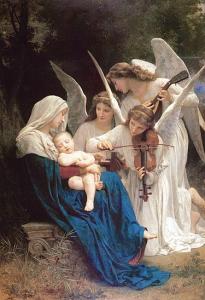
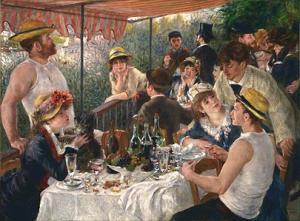
News of the World
- Watch Tower Bible and Tract Society or the Jehovah’s Witnesses is founded by restorationist minister Charles Taze Russell.
- January 25 – Thomas Edison and Alexander Graham Bell form the Oriental Telephone Company.
- February 19 – Kansas becomes the first U.S. state to prohibit all alcoholic beverages.
- March 4 – James A. Garfield is sworn in as the 20th president of the United States.
- April 28 – Billy the Kid escapes from his 2 jailers at the Lincoln County Jail in Mesilla, New Mexico, killing James Bell and Robert Ollinger, before stealing a horse and riding out of town.
- May 21 – The American Red Cross is established by Clara Barton.
- July 2 – Assassination of James A. Garfield: United States President James A. Garfield is shot by lawyer Charles J. Guiteau in Washington, D.C. The wound becomes infected, killing Garfield on September 19.
- September 12 – Francis Howell High School (Howell Institute) in St. Charles, Missouri, and Stephen F. Austin High School in Austin, Texas, open on the same day, putting them in a tie for the title of the oldest public high school west of the Mississippi River
- September 20 – President Chester A. Arthur is sworn in.
- October 26 – The Gunfight at the O.K. Corral occurs in Tombstone, Cochise County, Arizona, USA.
- December 28 – Virgil Earp is ambushed in Tombstone, Arizona, and loses the use of his left arm.
Arrivals
- Saint Titus Brandsma (February 23, 1881 –July 26, 1942) was a Dutch Carmelite friar, Catholic priest and professor of philosophy. Brandsma was vehemently opposed to Nazi ideology and spoke out against it many times before the Second World War. He was imprisoned at the Dachau concentration camp, where he was murdered.
- Margery Williams Bianco (July 22,1881 – September 4, 1944) the author of The Velveteen Rabbit and the Newbery Honor book Winterbound.
- P G Wodehouse (Oct 15, 1881 – Feb 14, 1975) was an English writer and one of the most widely read humorists of the 20th century. His creations include the feather-brained Bertie Wooster and his sagacious valet, Jeeves; the immaculate and loquacious Psmith; Lord Emsworth and the Blandings Castle set; the Oldest Member, with stories about golf; and Mr Mulliner, with tall tales on subjects ranging from bibulous bishops to megalomaniac movie moguls
- Pablo Picasso (October 25, 1881 – April 8, 1973) was one of the most influential artists of the 20th century.
- Pope John XXIII (November 25, 1881 – June 3, 1963) was head of the Catholic Church and sovereign of the Vatican City State from October 28, 1958 until his death in June 1963. Pope John XXIII surprised those who expected him to be a caretaker pope by calling the historic Second Vatican Council (1962–1965), the first session opening on October 11, 1962, which is now his feast.
Departures
- Fyodor Dostoevsky (Russian) (Nov 11, 1821 – Feb 09, 1881) author of Crime and Punishment (1866), The Idiot (1869) and The Brothers Karamazov (1880).
- American outlaw Billy the Kid (September 17 or November 23, 1859 – July 14, 1881)is shot and killed by Sheriff Pat Garrett (June 5, 1850 – February 29, 1908) in the Maxwell House at Fort Sumner, New Mexico.
- Anna McNeill Whistler (September 27, 1804 – January 31, 1881) was the mother of American-born, British-based painter James McNeill Whistler, who made her the subject of his famous painting Arrangement in Grey and Black No.1, often titled Whistler’s Mother.
- January 1, 1881 – American inventor George Eastman founds the Eastman Dry Plate Company, eventually known as Kodak
Publications Hot of the Press
- Mark Twain – The Prince and the Pauper (1881)
Margaret Sidney – Five Little Peppers and How They Grew (1881) - Bram Stoker – Under the Sunset (1881), comprising eight fairy tales for children.
Good Sports
- Detroit replaces Cincinnati leaving Cleveland and Providence the southerly cities on the National League circuit. Four others lie on the northerly rail line from stalwart Chicago to stalwart Boston: Detroit, Buffalo, Troy, and Worcester.
- In autumn, for the first time, all eight National League clubs prepare to continue next season.
Sanctifying Time
January 1, 1881 – Secrets of the Vatican Secret Archives! Pope Leo XIII allows a reading room open so that researchers can access The Vatican Archives. In an address to the Görres Society in February 1884, Pope Leo said: “Go to the sources. That is why I have opened the archives to you. We are not afraid of people publishing documents out of them.”
- Diuturnum – On the Origin of Civil Power, by Pope Leo XIII, 29 June 1881
- Licet Multa – On Catholics in Belgium, by Pope Leo XIII, 3 August 1881
The Sound of Music and Other Cultural Milestones
My Bonnie Lies over the Ocean“
1882
Picture This
Un Deuil by Daniel Ridgway Knight – Daniel Ridgway Knight
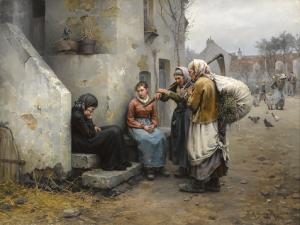
News of the World
- January 2
- The Standard Oil Trust is secretly created in the United States to control multiple corporations set up by John D. Rockefeller and his associates.
- Irish-born author Oscar Wilde arrives in New York at the beginning of a lecture tour of the United States and Canada.
January 5 – Charles J. Guiteau is found guilty of the assassination of James A. Garfield (President of the United States) and sentenced to death, despite an insanity defense raised by his lawyer.
- January 12 – Holborn Viaduct power station in the City of London, the world’s first coal-fired public electricity generating station, begins operation.[5]
- February 3 – American showman P. T. Barnum acquires the elephant Jumbo from the London Zoo.
- March 2 – Roderick Maclean fails in an attempt to assassinate Queen Victoria, at Windsor.
- March 22 – Polygamy is made a felony by the Edmunds Act, passed by the United States Congress.
- September 4 – Thomas Edison flips the switch to the first commercial electrical power plant in the United States, lighting one square mile of lower Manhattan. This is considered by many as the day that begins the electrical age.
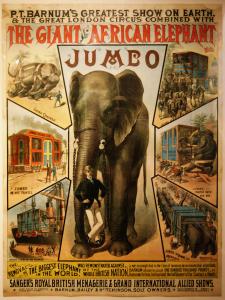
Arrivals
- A. A. Milne (Alan Alexander Milne) (January 18, 1882 – January 31, 1956) author of Winnie-the-Pooh,
- Virginia Woolf (January 25, 1882 – March 28, 1941) was an English writer. She is considered one of the most important modernist 20th-century authors. She pioneered the use of stream of consciousness as a narrative device.
- James Joyce (Irish) (February 2, 1882 –January 13, 1941) was an Irish novelist, poet and literary critic. He contributed to the modernist avant-garde movement and is regarded as one of the most influential and important writers of the 20th century. Joyce’s novel Ulysses (1922) is a landmark in which the episodes of Homer‘s Odyssey are paralleled in a variety of literary styles, particularly stream of consciousness. Other well-known works are the short-story collection Dubliners (1914), and the novels A Portrait of the Artist as a Young Man (1916) and Finnegans Wake (1939). His other writings include three books of poetry, a play, letters, and occasional journalism.
- Saint Anna Schäffer (February 18, 1882 – October 5, 1925) was a German woman who lived in Mindelstetten in Bavaria.
Departures
- Henry Wadsworth Longfellow (February 27, 1807 – March 24, 1882) was an American poet and educator. His original works include the poems “Paul Revere’s Ride“, “The Song of Hiawatha“, and “Evangeline“. He was the first American to completely translate Dante Alighieri‘s Divine Comedy and was one of the fireside poets from New England.
- Mary Elizabeth Lange (c. 1789 – February 3, 1882) was an American religious sister in Baltimore, Maryland who founded the Oblate Sisters of Providence in 1829, the first African-American religious congregation in the United States. She was also, via the Oblates, the first African-American superior general.
- Jesse James (September 5, 1847 – April 3, 1882) was an American outlaw, bank and train robber, guerrilla and leader of the James–Younger Gang. He is shot in the back of the head and killed by Robert Ford in St. Joseph, Missouri.
- Charles J. Guiteau, September 8, 1841 – June 30, 1882) American lawyer, assassin of James A. Garfield (d. 1882)
- Mary Todd Lincoln, (December 13, 1818 – July 16, 1882) served as the First Lady of the United States from 1861 until the assassination of her husband, President Abraham Lincoln, in 1865.
- 1882 – American inventor George Eastman begins experimenting with new types of photographic film, with his employee, William Walker.
- 1882 – French physiologist Étienne-Jules Marey invents the chronophotographic gun, the camera shaped like a rifle that photographs twelve successive images each second.
Publications Hot of the Press
- George MacDonald – The Gifts of the Child Christ and Other Tales (1882) and The Princess and Curdie (1882)
- Thomas Anstey Guthrie •Vice Versa; or, A Lesson to Fathers (1882)
Good Sports
- At the 1882 rules meeting, Walter Camp proposes that a team be required to advance the ball a minimum of five yards within three downs. These down-and-distance rules, combined with the already-established line of scrimmage, transform the game from a variation of rugby or association football into the distinct sport of American football.
Sanctifying Time
- Auspicato Concessum – On Saint Francis of Assisi, by Pope Leo XIII, 17 September 1882
- Cum Multa – On Conditions in Spain, by Pope Leo XIII, 8 December 1882
- Etsi Nos – On Conditions in Italy, by Pope Leo XIII, 15 February 1882
- miraculous cure at Lourdes of Elisa Seisson
The Sound of Music and Other Cultural Milestones
1883
Picture This
Jean-Léon Gérôme – The Christian Martyrs’ Last Prayer
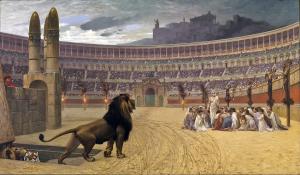
Pierre Auguste Cot – The Storm
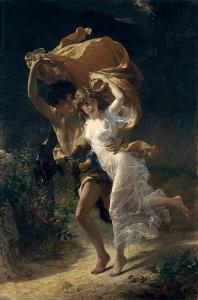
News of the World
- January 19 – The first electric lighting system employing overhead wires begins service in Roselle, New Jersey, United States, installed by Thomas Edison.
- April 5 – Oxygen is liquefied for the first time.
- May 24 – Brooklyn Bridge is opened to traffic in New York City, after 13 years of construction.
- June 28 – In Milan, Italy, the first central European electricity power station is inaugurated.
- July 4 – The world’s first rodeo is held in Pecos, Texas.
Arrivals
- Johnston McCulley (February 2, 1883 – November 23, 1958) was an American writer of hundreds of stories, fifty novels and numerous screenplays for film and television, and the creator of the character Zorro.
- Douglas Fairbanks (May 23, 1883 – December 12, 1939) was an American actor and filmmaker, best known for his swashbuckling roles in silent films.
- Benito Mussolini (July 29, 1883 – April 28, 1945) was an Italian dictator who founded and led the National Fascist Party (PNF). He was Prime Minister of Italy from the March on Rome in 1922, until his deposition in 1943, as well as Duce of Italian fascism from the establishment of the Italian Fasces of Combat in 1919, until his execution in 1945. As a dictator and founder of fascism, Mussolini inspired the international spread of fascist movements during the interwar period.
- Coco Chanel (August 19, 1883 – January 10, 1971) was a French fashion designer and businesswoman. The founder and namesake of the Chanel brand, she was credited in the post–World War I era with popularizing a sporty, casual chic as the feminine standard of style.
Departures
- Richard Wagner (May 22, 1813 – February 13, 1883) was a German composer, theatre director, polemicist, and conductor who is chiefly known for his operas (or, as some of his mature works were later known, “music dramas”).
- Karl Marx (May 5, 1818 – March 14, 1883) was a German-born philosopher, political theorist, economist, historian, sociologist, journalist, and revolutionary socialist and author of the 1848 pamphlet The Communist Manifesto (with Friedrich Engels)
- Samuel Mudd (December 20, 1833 – January 10, 1883) was an American physician who was imprisoned for conspiring with John Wilkes Booth concerning the assassination of Abraham Lincoln.
Publications Hot of the Press
- Carlo Collodi – The Adventures of Pinocchio: The Story of a Puppet (1883)
- Robert Louis Stevenson – Treasure Island (1883)
- Howard Pyle – The Merry Adventures of Robin Hood (1883)
- January 4, 1883 – Life magazine is founded in Los Angeles, California, United States.
Good Sports
- American Football- Modification of the scoring rules produces a system of four points for a touchdown, two points for kicks after touchdowns, two points for safeties, and five for field goals.
Sanctifying Time
- Saint Cyril of Alexandria proclaimed a Doctor of the Church
- Saint Cyril of Jerusalem proclaimed a Doctor of the Church
- miraculous cure at Lourdes of Sister Eugenia
- Oblates of the Sacred Heart suppressed
- Pope Leo XIII publishes the encyclical Supremi apostolatus officio (“On Devotion of the Rosary”).
The Sound of Music and Other Cultural Milestones
1884
Picture This
Albert Edelfelt – Boys Playing on the Shore
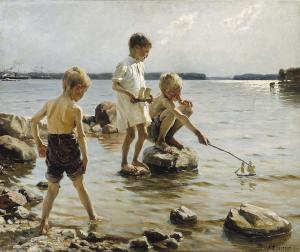
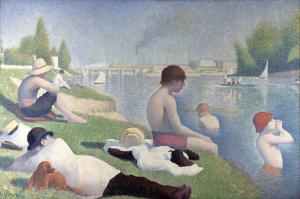
News of the World
- January 4 – The Fabian Society is founded in London.
- March – John Joseph Montgomery conducts the first manned glider flights in the United States near Otay, California.
- May 1 – The eight-hour workday is first proclaimed by the Federation of Organized Trades and Labor Unions in the United States. This date, called May Day or Labour Day, becomes a holiday recognized in almost every industrialized country.
- September 15 – The invention of local anesthesia by Karl Koller is made public at a medical congress in Heidelberg, Germany.
- December 1 – American Old West: Near Frisco, New Mexico, deputy sheriff Elfego Baca holds off a gang of 80 Texan cowboys, who want to kill him for arresting cowboy Charles McCarthy (the cowboys have been terrorizing the area’s Hispanos, and Baca is working against them).
Mysterious World
1884 – (Dark Matter, Dark Energy William Thomson, 1st Baron Lord Kelvin, OM, GCVO, PC, FRS, FRSE (June 26, 1824 – 17 December 17, 1907) gives a lecture where he becomes the first scientist to formulate the hypothetical concept of dark matter; he then attempted to define and locate some “dark bodies” in the Milky Way.
Arrivals
- Hugo Gernsback (August 16, 1884 – August 19, 1967) was an American editor and magazine publisher whose publications included the first science fiction magazine, Amazing Stories. His contributions to the genre as publisher were so significant that, along with the novelists Jules Verne and H. G. Wells, he is sometimes called “The Father of Science Fiction”.[1] In his honor, annual awards presented at the World Science Fiction Convention are named the “Hugos“
- Blessed James Alberione (April 4, 1884 –November 26, 1971) was an Italian Catholic priest, and the founder of the Society of St. Paul, of the Daughters of St. Paul, of the Pious Disciples of the Divine Master, of the Sisters of Jesus the Good Shepherd, of the Sisters of Mary Queen of the Apostles, and other religious institutes, which form the Pauline Family. The first two groups are best known for promoting the Catholic faith through various forms of modern media.
- Bradbury Robinson, (February 1, 1884 – March 7, 1949) was a pioneering American football player, who threw the first forward pass in American football history.
Departures
- Gregor Mendel, (July 20, 1822 – January 6, 1884) was an Austrian-Czech biologist, meteorologist, mathematician, Augustinian friar and abbot of St. Thomas’ Abbey in Brno (Brünn), Margraviate of Moravia.
- Alice Hathaway Lee Roosevelt (July 29, 1861 – February 14, 1884) was an American socialite and the first wife of President Theodore Roosevelt. Two days after giving birth to their only child, she died from undiagnosed Bright’s disease.
- Allan Pinkerton (August 21, 1819 – July 1, 1884) was a Scottish-American cooper, abolitionist, detective, and spy, best known for creating the Pinkerton National Detective Agency in the United States and his claim to have foiled a plot in 1861 to assassinate president-elect Abraham Lincoln.
- Martha Bulloch Roosevelt, (July 8, 1835 – February 14, 1884) was an American socialite. She was the mother of U.S. President Theodore Roosevelt and the paternal grandmother of Eleanor Roosevelt. She was a great-granddaughter of Archibald Bulloch, grandniece of William Bellinger Bulloch, and granddaughter of General Daniel Stewart. A true Southern belle raised in Georgia, Roosevelt is thought to have been one of the inspirations for Scarlett O’Hara.
On the Airwaves
Paul Nipkow invents the Nipkow disk, a means of scanning an image mechanically. This method is later used for mechanical television experiments.
Publications Hot of the Press
Thomas Anstey Guthrie (August 8, 1856 – 10 March 10, 1934)
•Vice Versa; or, A Lesson to Fathers (1882)
•The Giant’s Robe (1884)
- Mark Twain – Adventures of Huckleberry Finn
- George Fletcher Moore – Diary of Ten Years Eventful Life of an Early Settler in Western Australia
Good Sports
- Ned Williamson hits 27 home runs for the Chicago White Stockings, establishing a record that will last for 35 years. He nearly doubles the record of 14 set the season before by Harry Stovey.
- Moses Fleetwood Walker becomes the first black American major league baseball player when he makes his American Association league debut for the Toledo Blue Stockings.
- July 23 – The first tennis tournaments, held in the grounds of Shrubland Hall, Leamington Spa, England, are recorded in today’s Courier.
Sanctifying Time
The Sound of Music and Other Cultural Milestones
Rock-a-bye Baby” w.m. Effie I. Canning is credited with having written and composed the lullaby “Rock-a-bye Baby“; despite the words being in print in 1765. The rhyme exists in several versions. One modern example is the new-age lullaby – Rock A Bye Baby, where a mother attempts to tell his son how she feels for him. The beautiful rendition is written by Amitabh Bhattacharya and Julia Gartha, sung by Julia Gartha and Khatija Rahman, and composed by A.R.Rahman.
Oh My Darling, Clementine” w.m. Percy Montrose
1885
March 4 – Grover Cleveland is sworn in, as the 22nd president of the United States.
While Marty and Doc Traveled Through Time This Also Happened
1885, 1931, 1955, 1985, 2015
1886
Picture This
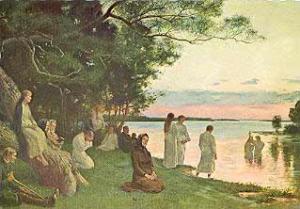
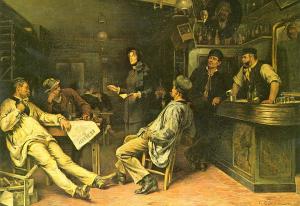
News of the World
- April 4 – William Ewart Gladstone introduces the First Irish Home Rule Bill in the Parliament of the United Kingdom; it is defeated on June 8.
- April 6 – The settlement of Vancouver, British Columbia, is incorporated.
- May 8 – American pharmacist Dr. John Pemberton invents a carbonated beverage that will be named ‘Coca-Cola‘.
- July 3 – Karl Benz officially unveils the Benz Patent Motorwagen.
- September 4 – American Indian Wars: After almost 30 years of fighting, Apache leader Geronimo surrenders, with his last band of warriors, to General Nelson Miles, at Skeleton Canyon in Arizona.
- October 7 – Spain abolishes slavery in Cuba.
- October 28 – U.S. President Grover Cleveland dedicates the Statue of Liberty, a gift from France, in New York Harbor. The ensuing spontaneous celebration in New York City leads to the first ticker tape parade.
- November 11 – Heinrich Hertz verifies the existence of electromagnetic waves, at the University of Karlsruhe.
- November 14 – German inventor Friedrich Soennecken first develops the hole puncher, a type of office tool capable of punching small holes in paper.
- Scotch whisky distiller William Grant & Sons is founded.
- Yorkshire Tea is established in Harrogate, England.
- Johnson & Johnson, which becomes a multinational brand, begins manufacturing healthcare products in New Jersey, United States.
- Avon Products, a worldwide cosmetics and household brand is founded in New York City, United States.[page needed]
- Food product and processing brand Del Monte Foods is founded in California, United States.
Mysterious World
- 1886 – Ancient Egyptian Murder Mystery The mummy of Ramesses III is discovered by antiquarians and is regarded as the prototypical Egyptian Mummy in numerous Hollywood movies. His tomb (KV11) is one of the largest in the Valley of the Kings. Bob Brier showcases The Mystery of Mummies
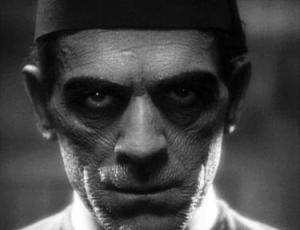
Arrivals
- Walter R. Brooks (January 9, 1886 – August 17, 1958) was an American writer, known for his children’s books about Freddy the Pig and the other anthropomorphic animal inhabitants of the Bean Farm in upstate New York, and also for his short stories about Mister Ed the talking horse, made into a television show after his death.
- Hugh Lofting (January 14, 1886 – September 26, 1947) was an English American writer, trained as a civil engineer, who created the classic children’s literature character Doctor Dolittle. The fictional physician to talking animals, based in an English village, first appeared in illustrated letters to his children which Lofting sent from British Army trenches in the First World War. Lofting settled in the United States soon after the war and before his first book was published.
- Father Edward J. Flanagan (July 13, 1886 – May 15, 1948) the founder of Boy’s Town.
- Charles Williams, (September 20, 1886 – May 15, 1945) was an author that was part of the literary circle known as The Inklings which included C.S. Lewis and J.R.R. Tolkien.
- Ty Cobb (December 18, 1886 – July 17, 1961), nicknamed “the Georgia Peach“, was an American professional baseball center fielder.
Departures
- Randolph Caldecott (March 22, 1846 – February 12,1886) The Caldecott Medal that annually recognizes the preceding year’s “most distinguished American picture book for children”was named in his honour.
- Mary Ewing Outerbridge (February 16, 1852 – May 3, 1886) was an American woman who imported the lawn game tennis to the United States from Bermuda.
- Ramakrishna (February 18, 1836 – August 16, 1886) was an Indian Hindu mystic. He was a devotee of the goddess Kali, but adhered to various religious practices from the Hindu traditions of Vaishnavism, Tantric Shaktism, and Advaita Vedanta, as well as Christianity and Islam. He advocated the essential unity of religions and proclaimed that world religions are “so many paths to reach one and the same goal”.[5] His parable-based teachings espoused the ultimate unity of diverse religions as being means to enable the realization of the same God. He is regarded by his followers as an avatar (divine incarnation).
- Uganda Martyrs: including Charles Lwanga and 12 other Catholic boys and men, and 9 Anglicans, are burned (and another Catholic speared) to death, at the orders of Kabaka Mwanga II of Buganda in Namugongo on June 3, 1886.
- Emily Dickinson, (December 10, 1830 – May 15, 1886) was an American poet. Little-known during her life, she has since been regarded as one of the most important figures in American poetry.
Publications Hot of the Press
- Louisa May Alcott – Jo’s Boys (1886).
- Personal Recollections of Joan of Arc (1886) Mark Twain
- Frances Hodgson Burnett – Little Lord Fauntleroy (1886)
- January 5–9, 1886 – Robert Louis Stevenson‘s novella Strange Case of Dr Jekyll and Mr Hyde is published in New York and London.
Good Sports
- The Sporting News established in St. Louis. It becomes the dominant American publication covering baseball, so much so that it acquires the nickname “The Bible of Baseball”.
- John L. Sullivan knocks out Paddy Ryan in the third round at San Francisco. Sullivan retains the World Heavyweight Championship.
John Lawrence Sullivan (October 15, 1858 – February 2, 1918), known simply as John L. among his admirers, and dubbed the “Boston Strong Boy” by the press, was an American boxer. He is recognized as the first heavyweight champion of gloved boxing, de facto reigning from February 7, 1882, to September 7, 1892. He is also generally recognized as the last heavyweight champion of bare-knuckle boxing under the London Prize Ring Rules, being a cultural icon of the late 19th century America, arguably the first boxing superstar and one of the world’s highest-paid athletes of his era. Newspapers’ coverage of his career, with the latest accounts of his championship fights often appearing in the headlines, and as cover stories, gave birth to sports journalism in the United States and set the pattern internationally for covering boxing events in media, and photodocumenting the prizefights.
Patrick Ryan (March 15, 1851 – December 14,1900) was an Irish American boxer, and became the bare-knuckle American heavyweight champion on May 30, 1880, after he won the title from Joe Goss. He retained the title until losing it to the exceptional John L. Sullivan on February 7, 1882.
Ryan fought only ten major bouts, but as many as twenty-five exhibitions including many Sullivan in his late career. Exhibitions brought him income, but with fewer rounds and less risk.
Sanctifying Time
- April 24 – Father Augustine Tolton, the first Roman Catholic priest from the United States to identify himself publicly as African American, is ordained in Rome.
- Iampridem – On Catholicism in Germany, by Pope Leo XIII, 6 January 1886
- Pergrata – On the Church in Portugal, by Pope Leo XIII, 14 September 1886
- Quod Multum – On the Liberty of the Church, by Pope Leo XIII, 22 August 1886
The Sound of Music and Other Cultural Milestones
- May 1 – The final version of Tchaikovsky‘s overture-fantasy Romeo and Juliet is performed for the first time, in Tbilisi (at this time part of the Russian Empire) under Mikhail Ippolitov-Ivanov.
John Philip Sousa – “The Gladiator” March
Camille Saint-Saëns – The Carnival of the Animals, Symphony No. 3 (Organ)
1887
Picture This
William Gerard Barry – Time Flies
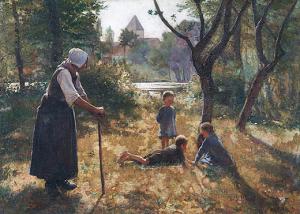
News of the World
- January 11 – Louis Pasteur‘s anti-rabies treatment is defended in the Académie Nationale de Médecine, by Dr. Joseph Grancher.
- January 20 -The United States Senate allows the Navy to lease Pearl Harbor as a naval base.
- March 3 – Anne Sullivan begins teaching Helen Keller.
- March 13 – Chester Greenwood patents earmuffs in the United States
- July 6 – King Kalākaua of Hawai’i is forced by anti-monarchists to sign the ‘Bayonet Constitution‘, stripping the Hawaiian monarchy of much of its authority, as well as disenfranchising most native Hawaiians, all Asians and the poor.
Mysterious World
- January 30, 1887 – The Greenbrier Ghost! In 1897, a West Virginia woman was murdered, but then her ghost revealed to her mother from beyond the grave what really happened. Many West Virginians will recognize this story because they have seen the historical mile marker dedicated to the Greenbrier Ghost, described as the “only ghost to testify in a murder trial.” In January 1897, young Zonie Shue was discovered dead in her home in Greenbrier County, apparently of natural causes. Some weeks after her burial, her ghost appeared at the bedside of her mother, Mary Jane Heaster, telling her that she had in fact been murdered. The appearance of the ghost led to the case being re-opened. The body was exhumed, new evidence was gathered, and ultimately Zona’s husband, Trout Shue, was convicted of murder and sentenced to life imprisonment.
Arrivals
- Saint Padre Pio (May 25, 1887 – 23 September 1968) was an Italian Capuchin friar, priest, stigmatist, and mystic.
- Chico Marx (March 22, 1887 – October 11, 1961) He was the oldest brother in the Marx Brothers comedy troupe, alongside his brothers Arthur (“Harpo”), Julius (“Groucho”), Milton (“Gummo”) and Herbert (“Zeppo”). His persona in the act was that of a charming, uneducated but crafty con artist, seemingly of rural Italian origin, who wore shabby clothes and sported a curly-haired wig and Tyrolean hat. On screen, Chico is often in alliance with Harpo, usually as partners in crime, and is also frequently seen trying to con or outfox Groucho. Leonard was the oldest of the Marx Brothers to live past early childhood, the first-born being Manfred Marx who had died in infancy. In addition to his work as a performer, he played an important role in the management and development of the act in its early years.
- Jim Thorpe, (May 22 or 28, 1887 – March 28, 1953) was an American athlete and Olympic gold medalist. A member of the Sac and Fox Nation, Thorpe was the first Native American to win a gold medal for the United States in the Olympics. Considered one of the most versatile athletes of modern sports, he won two Olympic gold medals in the 1912 Summer Olympics (one in classic pentathlon and the other in decathlon). He also played football (collegiate and professional), professional baseball, and professional basketball.
- Blessed Isidore Bakanja (c. 1887 – August 15, 1909: Aged 21-22) was a Congolese Catholic layman and bricklayer who suffered martyrdom in 1909 and was beatified on April 24, 1994 by Pope John Paul II. Due to the nature of his martyrdom, he is sometimes referred to as “martyr of the Brown scapular”.
- Boris Karloff (November 23, 1887 – February 2, 1969), was an English actor. His portrayal of Frankenstein’s monster in the horror film Frankenstein (1931), his 82nd film, established him as a horror icon, and he reprised the role for the sequels Bride of Frankenstein (1935) and Son of Frankenstein (1939). He also appeared as Imhotep in The Mummy (1932), and voiced the Grinch in, as well as narrating, the animated television special of Dr. Seuss‘ How the Grinch Stole Christmas! (1966), which won him a Grammy Award.
Departures
- Anandi Gopal Joshi, (March 31, 1865 – February 26, 1887) was the first Indian female doctor of western medicine. She was the first woman from the erstwhile Bombay presidency of India to study and graduate with a two-year degree in western medicine in the United States.
- Aleksandr Ulyanov, (April 2, 1866 – May 20, 1887) was a Russian revolutionary and political activist. He was the elder brother of Vladimir Lenin, the founder of the Soviet Union.
- Henry Ward Beecher, (June 24, 1813 – March 8, 1887) was an American Congregationalist clergyman, social reformer, and speaker, known for his support of the abolition of slavery, his emphasis on God’s love, and his 1875 adultery trial. His rhetorical focus on Christ’s love has influenced mainstream Christianity through the 21st century. Several of his brothers and sisters became well-known educators and activists, most notably Harriet Beecher Stowe, who achieved worldwide fame with her abolitionist novel Uncle Tom’s Cabin.
- Dorothea Dix, (April 4, 1802 – July 17, 1887) was an American advocate on behalf of the indigent mentally ill who, through a vigorous and sustained program of lobbying state legislatures and the United States Congress, created the first generation of American mental asylums. During the Civil War, she served as a Superintendent of Army Nurses.
- Doc Holliday (August 14, 1851 – November 8, 1887), better known as Doc Holliday, was an American dentist, gambler, and gunfighter who was a close friend and associate of lawman Wyatt Earp. Holliday is best known for his role in the events surrounding and his participation in the Gunfight at the O.K. Corral in Tombstone, Arizona. He developed a reputation as having killed more than a dozen men in various altercations, but modern researchers have concluded that, contrary to popular myth-making, Holliday killed only one to three men. Holliday’s colorful life and character have been depicted in many books and portrayed by well-known actors in numerous movies and television series.
Man Walking Around a Corner was an early film, shot by Louis Le Prince. According to David Wilkinson’s 2015 documentary The First Film it is not a film, but a series of photographs, 16 in all, each taken from one of the lens from Le Prince’s camera. Le Prince went on to develop the one-lens camera and on the 14th October 1888 he finally made the world’s first moving image.
Publications Hot of the Press
- Sir Arthur Conan Doyle –Sherlock Holmes in A Study in Scarlet (1887)
- Robert Louis Stevenson – The Merry Men and Other Tales and Fables
- H. Rider Haggard
Good Sports
- American Football – The rules are changed so that gametime is set at two halves of 45 minutes each (as in Association football). Two paid officials, a referee and an umpire, are mandated for each game.
- The two major leagues agree to a unified set of rules.
- The National Colored Base Ball League plays for a few weeks before folding.
- Five black men play in the International League, the highest minor league, the high-water mark in racial integration of professional baseball.
- Wimbledon Women’s Singles Championship – Lottie Dod (September 24, 1871 – June 27, 1960) the youngest ever Wimbledon champion at 15 (GB) defeats Blanche Bingley (GB) 6–2 6–0
Sanctifying Time
February 8, 1887 – A venerated image on a cloak (tilmahtli) associated with the apparition is enshrined within the Basilica of Our Lady of Guadalupe in Mexico City. Pope Leo XIII granted the image a decree of canonical coronation on this date and it was pontifically crowned on October 12, 1895. The basilica is the most-visited Catholic shrine in the world, and the world’s third most-visited sacred site.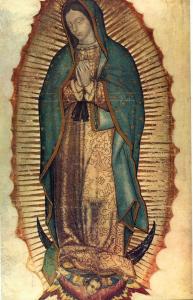
The Sound of Music and Other Cultural Milestones
Leaning on the Everlasting Arms is a hymn published in 1887 with music by Anthony J. Showalter and lyrics by Showalter and Elisha Hoffman.
Showalter said that he received letters from two of his former pupils saying that their wives had died. When writing letters of consolation, Showalter was inspired by the phrase in the Book of Deuteronomy 33:27, “The eternal God is thy refuge, and underneath are the everlasting arms”.
The song has been used in several movies, including The Human Comedy (1943), “Native Son” (1950), The Night of the Hunter (1955), Phase IV (1974), Wild Bill (1995), Next of Kin (1989), True Grit (2010) (of which it forms about a quarter of the score[3]) and First Reformed (2017).
1888
Picture This
The Lady of Shalott (painting) – Wikipedia 1888
Café Terrace at Night – Wikipedia 1888
- 1888 – Edward Burne-Jones – The Nativity
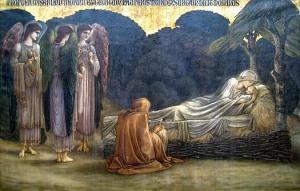
News of the World
- January 12 – The Schoolhouse Blizzard hits Dakota Territory, the states of Montana, Minnesota, Nebraska, Kansas, and Texas, leaving 235 dead, many of them children on their way home from school.
- January 13 – The National Geographic Society is founded in Washington, D.C.
- March 11 – The Great Blizzard of 1888 begins along the eastern seaboard of the United States, shutting down commerce and killing more than 400.
- April 3
- London prostitute Emma Elizabeth Smith is brutally attacked by two or three men, dying of her injuries the following day, first of the Whitechapel murders, but probably not a victim of Jack the Ripper.
- The Brighton Beach Hotel in Coney Island (New York) is moved 520 ft (160 m), using six steam locomotives, by civil engineer B. C. Miller, to save it from ocean storms.
- April 6 – The first New Year’s Day is observed, of the solar calendar adopted by Siamese King Chulalongkorn, with the 106th anniversary of Bangkok‘s founding in 1782 as its epoch (reference date).
- May 13 – In Brazil, the Lei Áurea abolishes the last remnants of slavery.
- June 19 – In Chicago, the Republican Convention opens at the Auditorium Building. Benjamin Harrison and Levi P. Morton win the nominations for President and Vice President of the United States, respectively.
- June 29 – Handel’s Israel in Egypt is recorded onto wax cylinder at The Crystal Palace in London, the earliest known recording of classical music.
- August 1 – Carl Benz is issued with the world’s first driving licence by the Grand Duchy of Baden.
- August 28 – The longest date in Roman numerals (XXVIII-VIII-MDCCCLXXXVIII) occurs.
- August 31 – Whitechapel murders: The mutilated body of London prostitute Mary Ann Nichols is found; she is considered the first victim of Jack the Ripper.
- September 27 –Whitechapel murders: The ‘Dear Boss letter‘ signed “Jack the Ripper“, the first time the name is used, is received by London’s Central News Agency.
- November 8 – Joseph Assheton Fincher files a patent in the United Kingdom for the parlour game which he calls “Tiddledy-Winks“.
- November 9 – Whitechapel murders: The mutilated body of London prostitute Mary Jane Kelly is found. She is considered to be the fifth, and last, of Jack the Ripper‘s victims. A number of similar murders in England follow, but the police attribute them to copy-cat killers.
- November 27 – International sorority Delta Delta Delta is founded at Boston University in the United States.
- November 29 – The celebration of Thanksgiving (United States) and the first day of Hanukkah coincide.
- December 23 – During a bout of mental illness (and having quarreled with his friend Paul Gauguin), Dutch painter Vincent van Gogh infamously cuts off the lower part of his own left ear, taking it to a brothel, and is removed to the local hospital in Arles.
- August 31, 1888 – Whitechapel murders: The mutilated body of London prostitute Mary Ann Nichols is found; she is considered the first victim of Jack the Ripper.November 9, 1888 – Whitechapel murders: The mutilated body of London prostitute Mary Jane Kelly is found. She is considered to be the fifth, and last, of Jack the Ripper‘s victims. A number of similar murders in England follow, but the police attribute them to copy-cat killers.
Arrivals
- Ronald Knox (February 17, 1888 – August 24, 1957) He is remembered for his “Ten Commandments” for detective stories, which sought to codify a form of crime fiction in which the reader may participate by attempting to find a solution to the mystery before the fictional detective reveals it.
- Irving Berlin (May 11, 1888 – September 22, 1989) was an American songwriter. His music forms a large part of the Great American Songbook. Berlin received numerous honors including an Academy Award, a Grammy Award, and a Tony Award. He also received the Presidential Medal of Freedom from President Gerald R. Ford in 1977. Broadcast journalist Walter Cronkite stated he “helped write the story of this country, capturing the best of who we are and the dreams that shape our lives”.
- T. S. Eliot (September 26, 1888 – January 4, 1965) was a poet, essayist and playwright.[1] He is considered to be one of the 20th century’s greatest poets, as well as a central figure in English-language Modernist poetry. His use of language, writing style, and verse structure reinvigorated English poetry. He is also noted for his critical essays, which often reevaluated long-held cultural beliefs.
- Harpo Marx (November 23, 1888 – September 28, 1964) was an American comedian, actor, mime artist, and harpist, and the second-oldest of the Marx Brothers. In contrast to the mainly verbal comedy of his brothers Groucho and Chico, Harpo’s comic style was visual, being an example of vaudeville, clown and pantomime traditions. He wore a curly reddish blond wig and was silent in all his movie appearances,[3] instead blowing a horn[4] or whistling[5] to communicate. Marx frequently employed props[6] such as a horn cane constructed from a lead pipe, tape, and a bulbhorn.
Departures
- John Bosco SDB (August 16, 1815 – January 31, 1888) A follower of the spirituality and philosophy of Francis de Sales, Bosco was an ardent devotee of the Virgin Mary under the title Mary Help of Christians. He later dedicated his works to de Sales when he founded the Salesians of Don Bosco, based in Turin.
- Louisa May Alcott (November 29, 1832 – March 6, 1888) was an American novelist, short story writer, and poet best known for writing the novel Little Women (1868) and its sequels Good Wives (1869), Little Men (1871) and Jo’s Boys (1886).
- Black Bart (b. c. 1829; d. after February 28, 1888), also known as Black Bart, was an American outlaw noted for the poetic messages he left behind after two of his robberies. Often called Charley by his friends, he was also known as Charles (or C.E.) Bolton. Considered a gentleman bandit with a reputation for style and sophistication, he was one of the most notorious stagecoach robbers to operate in and around Northern California and Southern Oregon during the 1870s and 1880s.
- Richard Redgrave RA (April 30, 1804 – December 14, 1888) was an English landscape artist, genre painter, and administrator.
1888 – Louis Le Prince creates the oldest surviving film on October 14 1888. The Roundhay Garden Scene is recorded in Leeds, Yorkshire, England, the footage lasts a mere 2.11 seconds.The camera used was patented in the United Kingdom on 16 November 1888.
Publications Hot of the Press
Oscar Wilde – The Happy Prince and Other Tales (1888, fairy tales)
- Robert Louis Stevenson – The Black Arrow (book publication)
Good Sports
- Baseball – The last of many adjustments finally sets four balls and three strikes for a “walk” and a strikeout.
- Celtic Football Club is founded by members of the Marist Order, a teaching institute, as a way of raising money for a poor children’s charity. The club’s first ground is a piece of rented land not far from the present Celtic Park. Celtic’s first recorded match is a home “friendly” against Rangers; Celtic win 5–2 in what is therefore the inaugural “Old Firm Game“.
Sanctifying Time
- February 13, 1888 – Miraculous Spiral Staircase Jean-Baptiste Lamy (October 11, 1814 – February 13, 1888), was a French-American Roman Catholic prelate who served as the first Archbishop of Santa Fe, New Mexico. Willa Cather‘s novel Death Comes for the Archbishop is based on his life and career. It was this very bishop who commissioned a chapel be built for the the Sisters of Loretto for their girls’ school, Loretto Academy, in 1873. After the chapel was built it lacked a staircase to the choir loft. Not being able to find someone to complete the task the sisters began a 9-day novena and low and behold on the last day the novena a mysterious stranger showed up and offered to build the staircase for them. He built a miraculous spiral staircase that seemed to defy physics as it ascended 20 feet (6.1 m) without any obvious means of support. After the man finished the staircase. He disappeared. Could the mysterious stranger who built the chapel be St. Joseph himself?The story was the subject of the 1998 television film The Staircase, starring Barbara Hershey and William Petersen.The case was investigated and subsequently re-enacted in the Unsolved Mysteries episode “Miracle Staircase”.Young-adult author Ann Rinaldi based her book The Staircase on the Loretto Chapel.
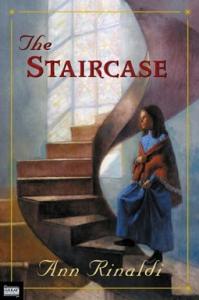
The Sound of Music and Other Cultural Milestones
- August 14 – A recording of Arthur Sullivan‘s “The Lost Chord” is played during a press conference introducing Thomas Edison‘s phonograph in London.
- “Drill, Ye Tarriers, Drill” anonymous possibly Thomas F. Casey
- “Over The Waves” (“Sobre las Olas”) w.m. Juventino Rosas
- “Where Did You Get That Hat?” w.m. Joseph J. Sullivan
Next Time on
While Marty and Doc Traveled Through Time This Also Happened
To Understand
What I love and How I Write About History
Hit the Link Above.
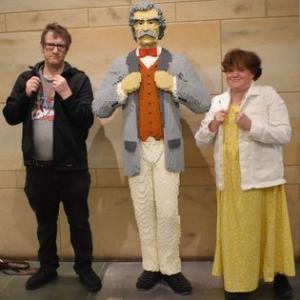
To understand about this particular series I’m writing about, please read
The Catholic Bard’s Guide To History Introduction
And to view a historical article click on


